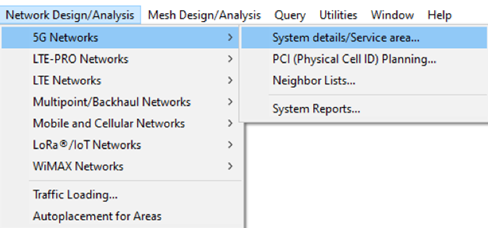...
This contains a new planning dialogue, algorithm, RAN Node entry and study
...
PCI is an important aspect of LTE & 5G planning. PCI (physical cell identifier) the physical cell id used to recognize and sort cells from the radio perspective, this is required for DL synchronization.
...
The PCI is obtained with the following formula.
PCI = (3 × SSS) + PSS
Where PSS contains values 0,1 & 2 and SSS contains 0-167 for LTE and 5G is from 0-335
PCI Planning in SignalPro
As a starting point we allow the user to either bring into their project the pre-defined PCI’s from their existing project OR to plan a new PCI plan for their new project.
...
The RAN Node is found in the system setting for the technology (5G or LTE-PRO) under the network design/analysis tab
...
Open the RAN NODE workbook ->Go to the Sectors Tab
...
The user should set up the planning parameters for the most optimal & user defined rules.
The First Container
...
The Excluded PCI; In this box the excluded PCI values should be added. These values will not be used in the planning of PCI’s. Very important for preserving PCI from your plan for later use or restrictions on PCIs
...
SS-RSRP Min; This is the minimum SS-RSRP level detected for each cell to determine unique PCI on overlapping areas
Second Container
...
Within this container rules are set for confusion, mod 3, mod 4 and compactness
...
Minimum area overlap is the minimum overlap for coverage that should be considered
Compactness
...
This ensures that the PCI used are limited to smaller numbers unless all ranges can be used. This is to preserve PCIs for growth
...
Gravity weight: This is the weight that lower numbers are preferred
Container 3
...
This is where the parameters are set for the algorithm.
Temperature schedule: The temperature values given in the temperature schedule should be considered against the assigned conflict weights. . The final value of the schedule should be zero and it should monotonically approach it (i.e. temp should not go up). The goal is to freeze out higher weighted degrees of freedom by bring the temperature down. If you don’t start with a high enough temperature as a starting point then you may end up freezing out degrees of freedom before they have a chance to evolve
Dwell Time; The calculation dwells at each temperature a number of counts Dwell Time according to the dwell time variable.
Mutant Count: The algorithm maintains a list of PCI plans at each step. The number of PCI plans to maintain at each step is determined by the mutant count variable (MC).
Set this number to 1 and the algorithm will be simple. When the mutant count is greater than 1 the algorithm will mutate MC times with a final step which takes the best MC plans.
Container 4
...
...
This container is where the sectors are brought in to be planned
...
OR the group can be added from SignalPRO SignalPro by selecting the group in the “unlocked group”
...
